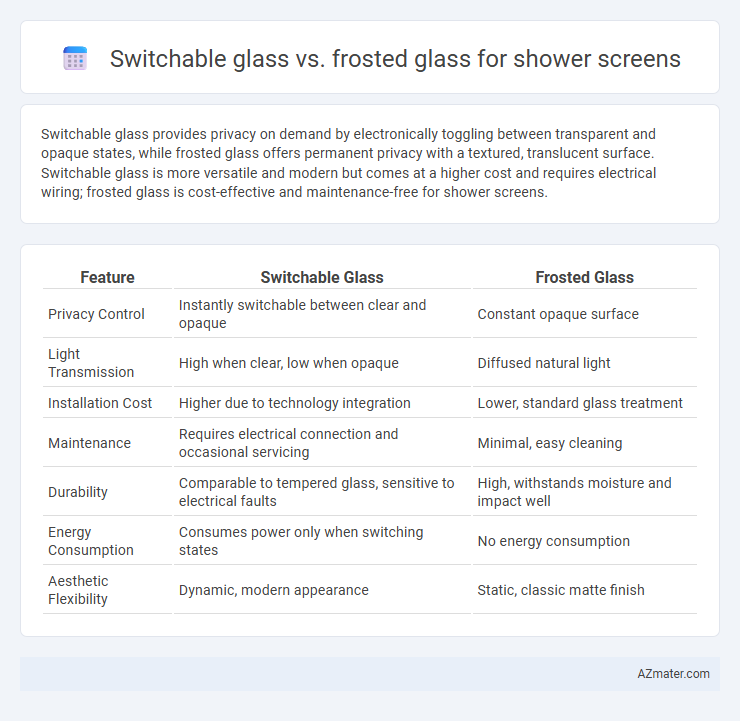Switchable glass provides privacy on demand by electronically toggling between transparent and opaque states, while frosted glass offers permanent privacy with a textured, translucent surface. Switchable glass is more versatile and modern but comes at a higher cost and requires electrical wiring; frosted glass is cost-effective and maintenance-free for shower screens.
Table of Comparison
| Feature | Switchable Glass | Frosted Glass |
|---|---|---|
| Privacy Control | Instantly switchable between clear and opaque | Constant opaque surface |
| Light Transmission | High when clear, low when opaque | Diffused natural light |
| Installation Cost | Higher due to technology integration | Lower, standard glass treatment |
| Maintenance | Requires electrical connection and occasional servicing | Minimal, easy cleaning |
| Durability | Comparable to tempered glass, sensitive to electrical faults | High, withstands moisture and impact well |
| Energy Consumption | Consumes power only when switching states | No energy consumption |
| Aesthetic Flexibility | Dynamic, modern appearance | Static, classic matte finish |
Introduction: Switchable Glass vs Frosted Glass
Switchable glass and frosted glass offer distinct privacy solutions for shower screens, with switchable glass utilizing liquid crystal technology to toggle between transparent and opaque states, while frosted glass provides a permanent translucent surface through acid etching or sandblasting. Switchable glass allows for dynamic privacy control and modern aesthetics, ideal for customizable bathroom environments. Frosted glass remains a cost-effective, low-maintenance option that diffuses light softly, ensuring consistent privacy without technological integration.
What is Switchable Glass?
Switchable glass, also known as smart glass, instantly changes from transparent to opaque with the application of an electrical current, offering customizable privacy in shower screens. Unlike frosted glass, which provides permanent opacity through surface treatment, switchable glass allows users to control visibility on demand. This technology enhances bathroom functionality by combining modern aesthetics with practical privacy solutions.
Understanding Frosted Glass
Frosted glass for shower screens provides privacy by creating a textured, opaque surface that diffuses light while maintaining a modern aesthetic. This type of glass is treated through sandblasting or acid etching to achieve its characteristic frosted appearance, which effectively obscures visibility without compromising natural light flow. Compared to switchable glass that changes opacity with electric voltage, frosted glass offers a low-maintenance, cost-effective solution ideal for consistent privacy in bathroom environments.
Privacy Levels: A Comparative Overview
Switchable glass offers dynamic privacy control by instantly changing from transparent to opaque with the flick of a switch, ensuring maximum privacy on demand. Frosted glass provides consistent, static privacy by obscuring visibility through its textured, sandblasted surface, but lacks adjustability. For shower screens, switchable glass delivers superior privacy flexibility, while frosted glass guarantees permanent, low-maintenance obscurity.
Maintenance and Cleaning Requirements
Switchable glass for shower screens requires minimal maintenance with easy surface wiping, as it resists stains and watermarks due to its glass composition and smart film technology. Frosted glass, while also durable, can accumulate soap scum and mineral deposits more visibly in its textured surface, demanding more frequent scrubbing and specialized glass cleaners to maintain clarity. Both materials benefit from regular cleaning, but switchable glass offers a more effortless upkeep experience, reducing the need for abrasive or chemical cleaning agents.
Aesthetic Appeal and Design Flexibility
Switchable glass offers a sleek, modern aesthetic with the ability to transition between transparent and opaque states, enhancing privacy on demand without compromising light flow in shower screens. Frosted glass provides a consistent, diffused appearance that adds a classic, elegant touch and effectively obscures visibility for privacy. Switchable glass enables dynamic design flexibility by adapting to different lighting and privacy needs, while frosted glass offers a timeless, low-maintenance solution with fixed opacity.
Energy Efficiency and Light Transmission
Switchable glass for shower screens offers superior energy efficiency by allowing users to control transparency, reducing the need for artificial lighting and enhancing privacy without compromising natural light transmission. Frosted glass diffuses light, maintaining privacy but significantly decreasing light transmission, which can increase reliance on additional lighting sources and energy consumption. Opting for switchable glass maximizes daylight usage while minimizing energy waste, making it a smarter choice for sustainable bathroom design.
Cost Comparison: Upfront and Long-term
Switchable glass for shower screens typically incurs a higher upfront cost, ranging from $150 to $300 per square foot, compared to frosted glass, which averages $50 to $100 per square foot. Long-term expenses for switchable glass include potential maintenance of electronic components and higher energy consumption, whereas frosted glass has minimal upkeep and no power requirements. Over time, frosted glass proves more economical due to its durability and lower operational costs, while switchable glass offers advanced privacy features at a premium price.
Durability and Safety Considerations
Switchable glass offers high durability with its laminated safety layers that prevent shattering, making it a secure option for shower screens. Frosted glass, typically made from tempered glass, ensures strength and resistance to impact, reducing the risk of injury upon breakage. Both types meet safety standards, but switchable glass provides added control over privacy without compromising structural integrity.
Choosing the Best Glass for Your Shower Screen
Switchable glass offers privacy at the flip of a switch, making it ideal for modern shower screens where versatility is key, while frosted glass provides constant privacy with a timeless, textured appearance that resists fingerprint marks and water spots. Switchable glass tends to be pricier and requires electrical installation but allows for seamless transitions between transparent and opaque states, enhancing both functionality and aesthetics. Frosted glass, more cost-effective and low-maintenance, excels in durability and consistent privacy, making it a practical choice for classic bathroom designs where budget and simplicity are priorities.

Infographic: Switchable glass vs Frosted glass for Shower screen
 azmater.com
azmater.com